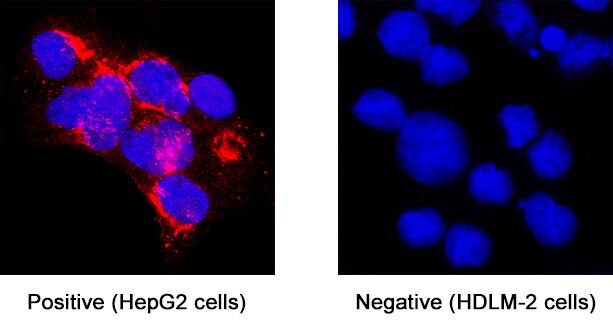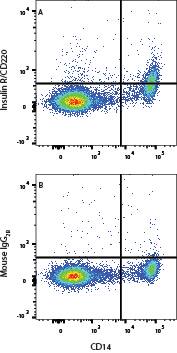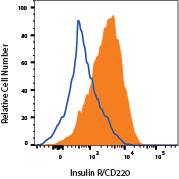Human Insulin R/CD220 Antibody
R&D Systems, part of Bio-Techne | Catalog # MAB1544


Key Product Details
Species Reactivity
Applications
Label
Antibody Source
Product Specifications
Immunogen
His28-Lys944
Accession # NP_001073285
Specificity
Clonality
Host
Isotype
Scientific Data Images for Human Insulin R/CD220 Antibody
Insulin R/CD220 in HepG2 Human Cell Line.
Insulin R/CD220 was detected in immersion fixed HepG2 human hepatocellular carcinoma cell line (positive staining) and HDLM-2 human Hodgkin’s lymphoma cell line (negative control) using Mouse Anti-Human Insulin R/CD220 Monoclonal Antibody (Catalog # MAB1544) at 8 µg/mL for 3 hours at room temperature. Cells were stained using the NorthernLights™ 557-conjugated Anti-Mouse IgG Secondary Antibody (red; NL007) and counterstained with DAPI (blue). Specific staining was localized to cell membrane and cytoplasm. Staining was performed using our protocol for Fluorescent ICC Staining of Non-adherent Cells.Detection of Insulin R/CD220 in PBMC by Flow Cytometry
PBMC were stained with Mouse Anti-Human CD14 PE-conjugated Monoclonal Antibody (Catalog # FAB3832P) and either (A) Mouse Anti-Human Insulin R/CD220 Monoclonal Antibody (Catalog # MAB1544) or (B) Mouse IgG2B Isotype Control (Catalog # MAB004) followed by Allophycocyanin-conjugated Anti-Mouse IgG Secondary Antibody (Catalog # F0101B). View our protocol for Staining Membrane-associated Proteins.Detection of Insulin R/CD220 in NS0 cell line transfected with hINSR vs irrelevant transfectant by Flow Cytometry
NSO cell line transfected with hINSR (filled histogram) vs irrelevant transfectant (open histogram) were stained with Mouse Anti-Human Insulin R/CD220 Monoclonal Antibody (Catalog # MAB1544) followed by Allophycocyanin-conjugated Anti-Mouse IgG Secondary Antibody (Catalog # F0101B). View our protocol for Staining Membrane-associated Proteins.Applications for Human Insulin R/CD220 Antibody
Flow Cytometry
Sample: Human peripheral blood monocytes, NS0 cell line transfected with hINSR vs irrelevant transfectant
Immunocytochemistry
Sample: Immersion fixed HepG2 human hepatocellular carcinoma cell line
Reviewed Applications
Read 1 review rated 5 using MAB1544 in the following applications:
Formulation, Preparation, and Storage
Purification
Reconstitution
Formulation
Shipping
Stability & Storage
- 12 months from date of receipt, -20 to -70 °C, as supplied.
- 1 month, 2 to 8 °C under sterile conditions after opening.
- 6 months, -20 to -70 °C under sterile conditions after opening.
Background: Insulin R/CD220
The Insulin Receptor (INS R) and insulin-like growth factor-1 receptor (IGF-I R) constitute a subfamily of receptor tyrosine kinases (1-4). The two receptors share structural similarity as well as overlapping intracellular signaling events, and are believed to have evolved through gene duplication from a common ancestral gene. INS R cDNA encodes a type I transmembrane single chain preproprotein with a putative 27 amino acid residues (aa) signal peptide. The large INS R extracellular domain is organized into two successive homologous globular domains, which are separated by a Cysteine-rich domain, followed by three fibronectin type III domains. The intracellular region contains the kinase domain sandwiched between the juxtamembrane domain used for docking insulin-receptor substrates (IRS), and the carboxy-terminal tail that contains two phosphotyrosine-binding sites. After synthesis, the single chain INS R precursor is glycosylated, dimerized and transported to the Golgi apparatus where it is processed at a furin-cleavage site within the middle fibronectin type III domain to generate the mature disulfide-linked alpha2 beta2 tetrameric receptor. The alpha subunit is localized extracellularly and mediates ligand binding while the transmembrane beta subunit contains the cytoplasmic kinase domain and mediates intracellular signaling. As a result of alternative splicing, two INS R isoforms (A and B) that differ by the absence or presence, respectively, of a 12 aa residue sequence in the carboxyl terminus of the alpha subunit exist. Whereas the A isoform is predominantly expressed in fetal tissues and cancer cells, the B isoform is primarily expressed in adult differentiated cells. Both the A and B isoforms bind insulin with high-affinity, but the A isoform has considerably higher affinity for IGF‑I and IGF-II. Ligand binding induces a conformational change of the receptor, resulting in ATP binding, autophosphorylation, and subsequent downstream signaling. INS R signaling is important in metabolic regulation, but may also contribute to cell growth, differentiation and apoptosis. Mutations in the INS R gene have been linked to insulin-resistant diabetes mellitus, noninsulin-dependent diabetes mellitus and leprechaunism, an extremely rare disorder characterized by abnormal resistance to insulin that results in a variety of distinguishing characteristics, including growth delays and abnormalities affecting the endocrine system. INS R is highly conserved between species, rat INS R shares 94% and 97% aa sequence homology with the human and mouse receptor, respectively.
References
- Nakae, J. et al. (2001) Endoc. Rev. 22:818.
- De Meyts, P. and J. Whittaker (2002) Nature Rev. Drug Disc. 1:769.
- Kim, J.J. and D. Accili (2002) Growth Hormone and IGF Res. 12:84.
- Sciacca, L. et al. (2003) Endocrinology 144:2650.
Long Name
Alternate Names
Gene Symbol
UniProt
Additional Insulin R/CD220 Products
Product Documents for Human Insulin R/CD220 Antibody
Product Specific Notices for Human Insulin R/CD220 Antibody
For research use only

